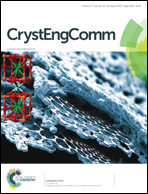Formation of composite dimers consisting of Ag2S and hollow structured Pd nanoparticles†
Abstract
Understanding the mechanism for the production of composite dimers, which often exhibit new properties not present in their individual components due to the electron transfer across the nanometer contact at the interface, is undoubtedly important. Herein, with the assistance of a small amount of [AD]PO4, an organic soluble ionic liquid, core–shell Ag@Ag–Pd nanoparticles with an average size of 28.2 nm are successfully prepared, which serve as templates for the subsequent synthesis of dimeric nanocomposites consisting of Ag2S and hollow structured Pd nanoparticles (Ag2S–hPd) by converting the Ag component in the core–shell particles into Ag2S with elemental sulfur. Specifically, the large size of the core–shell nanoparticles allow us to observe clearly the ripening of Ag2S to a single site on the surface of the remnant hollow structured Pd nanoparticles, which elucidates the mechanism accounting for the formation of Ag2S–hPd composite dimers instead of core–shell nanostructures with a hollow Pd core and a continuous Ag2S shell, although the transformation from Ag to Ag2S occurred uniformly on the surface of the remnant hollow Pd particles. Electrochemical measurements demonstrate that the dimeric Ag2S–hPd nanocomposites display better electrocatalytic behavior for formic acid oxidation than commercial Pd/C catalysts due to the strong electronic coupling between the semiconductor and noble metal domains in the nanocomposites.


 Please wait while we load your content...
Please wait while we load your content...